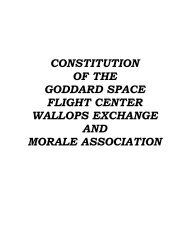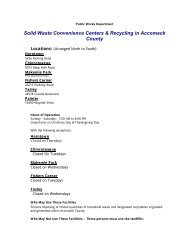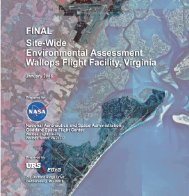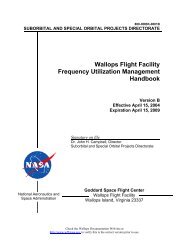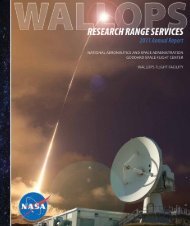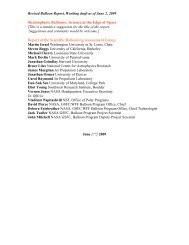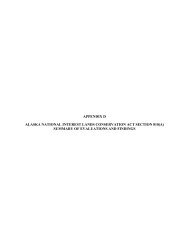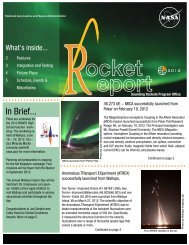Alternative Energy Draft EA - NASA Visitor Center at Wallops Flight ...
Alternative Energy Draft EA - NASA Visitor Center at Wallops Flight ...
Alternative Energy Draft EA - NASA Visitor Center at Wallops Flight ...
Create successful ePaper yourself
Turn your PDF publications into a flip-book with our unique Google optimized e-Paper software.
2.3 PROPOSED ACTION AND ALTERNATIVES<br />
Proposed Action and <strong>Altern<strong>at</strong>ive</strong>s<br />
The Proposed Action and <strong>Altern<strong>at</strong>ive</strong>s consist of developing renewable, self-sufficient energy<br />
sources <strong>at</strong> WFF to supplement the electricity currently supplied to WFF by the local electric<br />
cooper<strong>at</strong>ive. These altern<strong>at</strong>ive energy sources would consist of proven wind and/or solar<br />
technologies to assist WFF in meeting its goals of reducing impacts on the n<strong>at</strong>ural environment.<br />
The wind and solar sources would consume energy from a source th<strong>at</strong> provides zero GHG<br />
emissions, reduce WFF’s annual oper<strong>at</strong>ing costs, and set an example for responsible stewardship<br />
of n<strong>at</strong>ural resources by a Federal agency.<br />
2.3.1 Proposed Action: Utility-Scale Wind Turbines and Residential-Scale Wind Turbines<br />
Under the Proposed Action, <strong>NASA</strong>’s preferred altern<strong>at</strong>ive, <strong>NASA</strong> would construct two 2.0 MW<br />
“utility-scale” wind turbines on <strong>Wallops</strong> Island th<strong>at</strong> would be capable of gener<strong>at</strong>ing<br />
approxim<strong>at</strong>ely 10 GWh/year, and up to five 2.4 kW “residential-scale” wind turbines <strong>at</strong> the Main<br />
Base and Mainland.<br />
2.3.1.1 Utility-Scale Turbines<br />
The 2.0 MW wind turbines would be loc<strong>at</strong>ed on <strong>Wallops</strong> Island west of the U.S. Navy V-10/V-<br />
20 complex (Figure 6). A depiction of the wind turbines is shown on Figure 7. The general<br />
specific<strong>at</strong>ions of a represent<strong>at</strong>ive 2.0 MW wind turbine (Gamesa, 2009) include:<br />
Three composite (non-metal) rotor blades<br />
The diameter of the rotor blades is 87 meters (285 feet)<br />
A height of 120.5 meters (395 feet) <strong>at</strong> the top of the blade<br />
A rot<strong>at</strong>ion speed of 9 to 19 revolutions per minute<br />
Independent pitch control th<strong>at</strong> allows rotor blades to autom<strong>at</strong>ically turn to face oncoming<br />
wind<br />
The gener<strong>at</strong>or and gearbox are supported by elastomeric elements to minimize noise<br />
emissions<br />
Braking system<br />
The wind turbines would be constructed with a setback distance of 153 meters (500 feet) from<br />
existing towers and buildings. The finished subsurface footprint of each wind turbine would be<br />
approxim<strong>at</strong>ely 13 meters (42 feet) in diameter, with a 4.6-meter-diameter (15-foot-diameter)<br />
surface found<strong>at</strong>ion. The found<strong>at</strong>ion of the turbines would be pre-cast concrete piles installed to a<br />
depth of approxim<strong>at</strong>ely 30 meters (100 feet) below the ground surface.<br />
A corridor 9.7 meters (32 feet) wide would be constructed for access roads to each wind turbine,<br />
including approxim<strong>at</strong>ely 4.9 meters (16 feet) for a permanent gravel road surface and an<br />
additional 2.4 meters (8 feet) on each side for road shoulders.<br />
Previously disturbed areas, including the cleared area east of the U.S. Navy V-10/V-20 complex,<br />
would be used for staging of equipment and m<strong>at</strong>erials, and for construction vehicle parking. The<br />
construction period for two wind turbines would be approxim<strong>at</strong>ely 6 months.<br />
21



